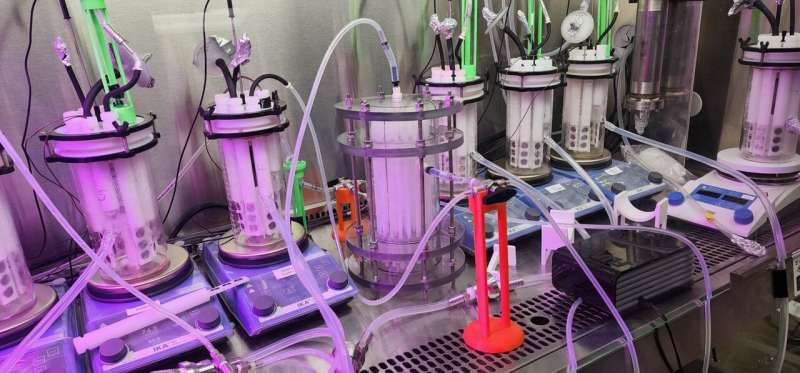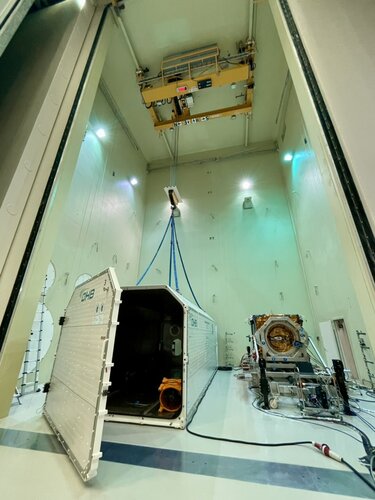
Copernical Team
Thursday, 11 July 2024 11:00
Mpemba effect at Concordia
 Image:
Freezing boiling water in Concordia against the sunset
Image:
Freezing boiling water in Concordia against the sunset
Published in
News
Tagged under
Thursday, 11 July 2024 11:20
YPSat: the view from Ariane 6

If there had been an astronaut aboard the historic first launch of Europe’s Ariane 6 launcher, this is what they would have seen: images and videos from key phases of the flight were captured by the YPSat payload, a project led and undertaken by ESA Young Professionals in their own time.
Published in
News
Tagged under
Thursday, 11 July 2024 07:20
NASA researchers battle biofilm in space

Published in
News
Tagged under
Thursday, 11 July 2024 17:34
Satellites Assist Relief Operations After Dike Breach in Central China
Sydney, Australia (SPX) Jul 09, 2024
 China has deployed several remote sensing satellites to support rescue and relief efforts after a dike breach on Friday at Dongting Lake in central Hunan Province.
The China Centre For Resources Satellite Data and Application (CRESDA) reported that Gaofen-3 02, Gaofen-3 03, Gaofen-1, and Gaofen-4 satellites are providing real-time monitoring of the affected areas.
CRESDA confirmed th
China has deployed several remote sensing satellites to support rescue and relief efforts after a dike breach on Friday at Dongting Lake in central Hunan Province.
The China Centre For Resources Satellite Data and Application (CRESDA) reported that Gaofen-3 02, Gaofen-3 03, Gaofen-1, and Gaofen-4 satellites are providing real-time monitoring of the affected areas.
CRESDA confirmed th
 China has deployed several remote sensing satellites to support rescue and relief efforts after a dike breach on Friday at Dongting Lake in central Hunan Province.
The China Centre For Resources Satellite Data and Application (CRESDA) reported that Gaofen-3 02, Gaofen-3 03, Gaofen-1, and Gaofen-4 satellites are providing real-time monitoring of the affected areas.
CRESDA confirmed th
China has deployed several remote sensing satellites to support rescue and relief efforts after a dike breach on Friday at Dongting Lake in central Hunan Province.
The China Centre For Resources Satellite Data and Application (CRESDA) reported that Gaofen-3 02, Gaofen-3 03, Gaofen-1, and Gaofen-4 satellites are providing real-time monitoring of the affected areas.
CRESDA confirmed th
Published in
News
Tagged under
Thursday, 11 July 2024 17:34
GOES-U Satellite Achieves Geostationary Orbit and Becomes GOES-19
Los Angeles CA (SPX) Jul 10, 2024
 On July 7, 2024, NOAA's GOES-U completed its final engine burn, successfully entering geostationary orbit 22,236 miles above the Earth's equator. Following this achievement, the satellite has been renamed GOES-19. GOES satellites are initially designated with a letter before launch, which is then changed to a number once they reach geostationary orbit.
GOES-U was launched on June 25, 2024,
On July 7, 2024, NOAA's GOES-U completed its final engine burn, successfully entering geostationary orbit 22,236 miles above the Earth's equator. Following this achievement, the satellite has been renamed GOES-19. GOES satellites are initially designated with a letter before launch, which is then changed to a number once they reach geostationary orbit.
GOES-U was launched on June 25, 2024,
 On July 7, 2024, NOAA's GOES-U completed its final engine burn, successfully entering geostationary orbit 22,236 miles above the Earth's equator. Following this achievement, the satellite has been renamed GOES-19. GOES satellites are initially designated with a letter before launch, which is then changed to a number once they reach geostationary orbit.
GOES-U was launched on June 25, 2024,
On July 7, 2024, NOAA's GOES-U completed its final engine burn, successfully entering geostationary orbit 22,236 miles above the Earth's equator. Following this achievement, the satellite has been renamed GOES-19. GOES satellites are initially designated with a letter before launch, which is then changed to a number once they reach geostationary orbit.
GOES-U was launched on June 25, 2024,
Published in
News
Tagged under
Thursday, 11 July 2024 17:34
Fleet Space's ExoSphere Advances Barrick Gold's Copper Exploration at Reko Diq
Sydney, Australia (SPX) Jul 10, 2024
 Fleet Space Technologies, a leading Australian space exploration company, has announced the deployment of its comprehensive mineral exploration solution, ExoSphere, to support Barrick Gold's copper exploration efforts at the Reko Diq project in Pakistan. Utilizing advanced space technology, AI, and 3D multiphysics, ExoSphere is creating detailed 3D subsurface maps of groundwater systems and copp
Fleet Space Technologies, a leading Australian space exploration company, has announced the deployment of its comprehensive mineral exploration solution, ExoSphere, to support Barrick Gold's copper exploration efforts at the Reko Diq project in Pakistan. Utilizing advanced space technology, AI, and 3D multiphysics, ExoSphere is creating detailed 3D subsurface maps of groundwater systems and copp
 Fleet Space Technologies, a leading Australian space exploration company, has announced the deployment of its comprehensive mineral exploration solution, ExoSphere, to support Barrick Gold's copper exploration efforts at the Reko Diq project in Pakistan. Utilizing advanced space technology, AI, and 3D multiphysics, ExoSphere is creating detailed 3D subsurface maps of groundwater systems and copp
Fleet Space Technologies, a leading Australian space exploration company, has announced the deployment of its comprehensive mineral exploration solution, ExoSphere, to support Barrick Gold's copper exploration efforts at the Reko Diq project in Pakistan. Utilizing advanced space technology, AI, and 3D multiphysics, ExoSphere is creating detailed 3D subsurface maps of groundwater systems and copp
Published in
News
Tagged under
Thursday, 11 July 2024 17:34
Spire Global Secures CA 1.41 Million Canadian Government Contract for Ship Tracking
Berlin, Germany (SPX) Jul 09, 2024
 Spire Global, Inc. (NYSE: SPIR), a leader in space-based data, analytics, and space services, has been awarded a CA $1.41 million contract by the Government of Canada (GoC) to provide global automatic identification system (AIS) ship tracking data. The one-year agreement includes options for two additional years, potentially increasing the total value to nearly CA $4.23 million.
"We are pr
Spire Global, Inc. (NYSE: SPIR), a leader in space-based data, analytics, and space services, has been awarded a CA $1.41 million contract by the Government of Canada (GoC) to provide global automatic identification system (AIS) ship tracking data. The one-year agreement includes options for two additional years, potentially increasing the total value to nearly CA $4.23 million.
"We are pr
 Spire Global, Inc. (NYSE: SPIR), a leader in space-based data, analytics, and space services, has been awarded a CA $1.41 million contract by the Government of Canada (GoC) to provide global automatic identification system (AIS) ship tracking data. The one-year agreement includes options for two additional years, potentially increasing the total value to nearly CA $4.23 million.
"We are pr
Spire Global, Inc. (NYSE: SPIR), a leader in space-based data, analytics, and space services, has been awarded a CA $1.41 million contract by the Government of Canada (GoC) to provide global automatic identification system (AIS) ship tracking data. The one-year agreement includes options for two additional years, potentially increasing the total value to nearly CA $4.23 million.
"We are pr
Published in
News
Tagged under
Thursday, 11 July 2024 06:40
Hera in the doghouse
 Image:
Hera in the doghouse
Image:
Hera in the doghouse
Published in
News
Tagged under
Thursday, 11 July 2024 14:35
Spectacular Red Sprites Captured from the ISS
Los Angeles CA (SPX) Jul 11, 2024
 NASA astronaut Matthew Dominick photographed red sprites in Earth's upper atmosphere from the International Space Station on June 3, 2024. The bright red flashes (more easily seen by clicking on the photo to see a larger version) are a less understood phenomena associated with powerful lightning events and appear high above the clouds in the mesosphere. Transient Luminous Events (TLEs), includin
NASA astronaut Matthew Dominick photographed red sprites in Earth's upper atmosphere from the International Space Station on June 3, 2024. The bright red flashes (more easily seen by clicking on the photo to see a larger version) are a less understood phenomena associated with powerful lightning events and appear high above the clouds in the mesosphere. Transient Luminous Events (TLEs), includin
Published in
News
Tagged under
Thursday, 11 July 2024 14:35
NextNav Receives DOT Award to Enhance PNT Services as GPS Backup
Los Angeles CA (SPX) Jul 11, 2024
 NextNav (Nasdaq: NN), a leader in advanced positioning, navigation, timing (PNT), and 3D geolocation, has announced receiving a new award from the U.S. Department of Transportation (U.S. DOT). This award will support real-world field tests of NextNav's 3D PNT technologies, designed to provide critical infrastructure with reliable PNT information when GPS is unavailable or compromised due to envi
NextNav (Nasdaq: NN), a leader in advanced positioning, navigation, timing (PNT), and 3D geolocation, has announced receiving a new award from the U.S. Department of Transportation (U.S. DOT). This award will support real-world field tests of NextNav's 3D PNT technologies, designed to provide critical infrastructure with reliable PNT information when GPS is unavailable or compromised due to envi
 NextNav (Nasdaq: NN), a leader in advanced positioning, navigation, timing (PNT), and 3D geolocation, has announced receiving a new award from the U.S. Department of Transportation (U.S. DOT). This award will support real-world field tests of NextNav's 3D PNT technologies, designed to provide critical infrastructure with reliable PNT information when GPS is unavailable or compromised due to envi
NextNav (Nasdaq: NN), a leader in advanced positioning, navigation, timing (PNT), and 3D geolocation, has announced receiving a new award from the U.S. Department of Transportation (U.S. DOT). This award will support real-world field tests of NextNav's 3D PNT technologies, designed to provide critical infrastructure with reliable PNT information when GPS is unavailable or compromised due to envi
Published in
News
Tagged under
